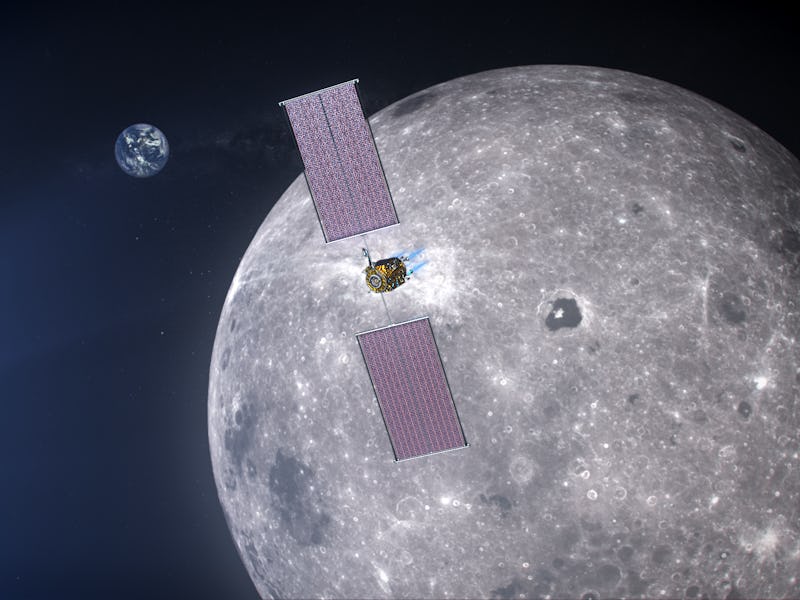NASA and SpaceX team up to launch the agency's lunar 'mobile home'
Apartment living, coming to an orbit near you.

Fifty years after Apollo, NASA is sending astronauts back to the Moon. The space agency's Artemis Program will put humans back on the Moon in the year 2024 — but the fun doesn't stop there. NASA ultimately plans to build the first orbiting outpost around Earth's natural satellite, a kind of lunar RV which can house astronauts on a near-continuous basis and act as a basecamp for trips to the Moon's surface.
To make it happen, NASA is turning to a now-familiar ally: SpaceX. On Tuesday, the agency announced Elon Musk's company has the contract to launch essential components of the Lunar Gateway into space, conveying them to their position in lunar orbit.
The contract, worth $332 million, tasks SpaceX with the launch of the first two parts of the moon-orbiting Gateway. As part of the space agency's Artemis program, the Lunar Gateway will be used as an outpost for astronauts — a pied-à-terre of sorts, if you will.
NASA's Artemis program has two phases:
1. The first is aims to put Americans back on the lunar surface.
2. The second is far more long-term: To build sustainable systems on and around the Moon.
The latter is an endeavor NASA deems "nothing short of advancing the cause of humanity," as per their promotional video, linked above.
How they will do it — The Gateway will be stationed tens of thousands of miles at its farthest distance from the lunar surface, and situated in a near-rectilinear halo orbit. The halo orbit is a precise balance point in the gravities of Earth and the Moon which will allow the Gateway to maintain long-term stability using only minimal energy.
An illustration showing the Gateway orbiting the Moon.
SpaceX will launch two components of the Gateway first:
- Power and Propulsion Element (PPE)
- Habitation and Logistics Outpost (HALO)
What is the Power and Propulsion Element?
The PPE is a propulsion system that will move the station to different positions in the Moon's orbit. It will also provide the outpost with electricity, using its solar arrays to harvest the Sun's energy. Through this sustainable system, the arrays will be able to power the Gateway for up to 15 years, according to NASA.
The power and propulsion element of NASA's Gateway is a high-power, 50-kilowatt solar electric propulsion spacecraft.
This craft is a "high-power, 50-kilowatt solar electric propulsion spacecraft," NASA says — three times more powerful than current, similar spacecraft, according to the agency.
"The power and propulsion element is the foundation of Gateway," former NASA administrator Jim Bridenstine said in a 2019 statement.
“It will be the key component upon which we will build our lunar Gateway outpost, the cornerstone of NASA’s sustainable and reusable Artemis exploration architecture on and around the Moon.”
The new power is necessary given the essential task the PPE must accomplish.
What is the Habitation and Logistics Outpost?
The PPE will ferry around the HALO unit of the Gateway. HALO, short for the Habitation and Logistics Outpost, will essentially serve as a mobile space home for astronauts on their way to the Moon.
HALO will be quite different to the International Space Station, according to NASA. A key difference will be the fact HALO can accommodate extended stays by astronauts far beyond those on the ISS. To enable astronauts to live in comfort, NASA describes HALO like a “small studio apartment,” replete with robust life support systems, and command and control capabilities to enable astronauts to prepare for trips to the Moon's surface.
"HALO will support science investigations, distribute power, provide communications for visiting vehicles and lunar surface expeditions, and supplement the life support systems aboard Orion, NASA’s spacecraft that will deliver Artemis astronauts to the Gateway," NASA said in a statement.
Illustration of NASA's Gateway in lunar orbit.
SpaceX/NASA launch contract: Key details
Together, the PPE and HALO are essentially the space equivalent of a way station, but instead of going on family road trips, this one will travel in an orbit around the Moon to transport astronauts back and forth to the lunar surface, as well as help in conducting science and discoveries from this unique position in space.
Altogether, the contract is expected to cost NASA some $331.8 million.
The two elements of the Lunar Gateway will launch together aboard a Falcon Heavy rocket in the year 2024, according to the NASA contract. At the moment, the launch is scheduled for no earlier than May, 2024, although as with all space launches, this may be subject to change depending on other elements of the Artemis program.
The launch will take place from the NASA Kennedy Space Center at Cape Canaveral in Florida, from Launch Complex 39A.